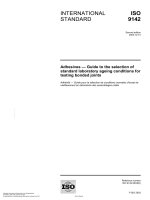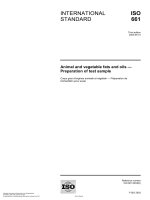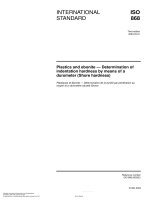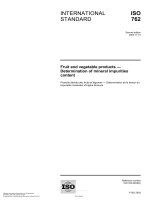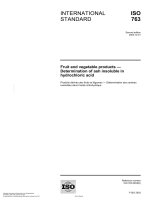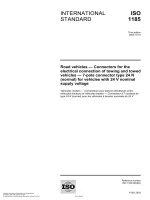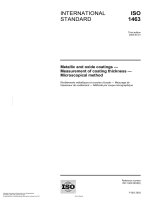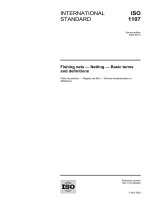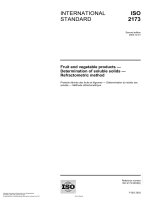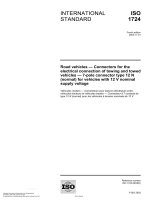Tiêu chuẩn iso 15169 2003
Bạn đang xem bản rút gọn của tài liệu. Xem và tải ngay bản đầy đủ của tài liệu tại đây (536.24 KB, 36 trang )
INTERNATIONAL
STANDARD
ISO
15169
First edition
2003-12-01
Petroleum and liquid petroleum
products — Determination of volume,
density and mass of the hydrocarbon
content of vertical cylindrical tanks by
hybrid tank measurement systems
Pétrole et produits pétroliers liquides — Détermination du volume, de la
masse volumique et de la masse d'hydrocarbures contenus dans les
réservoirs cylindriques verticaux à l'aide de systèmes hybrides de
mesurage
Reference number
ISO 15169:2003(E)
--`,,`,-`-`,,`,,`,`,,`---
Copyright International Organization for Standardization
Provided by IHS under license with ISO
No reproduction or networking permitted without license from IHS
© ISO 2003
Not for Resale
ISO 15169:2003(E)
PDF disclaimer
This PDF file may contain embedded typefaces. In accordance with Adobe's licensing policy, this file may be printed or viewed but
shall not be edited unless the typefaces which are embedded are licensed to and installed on the computer performing the editing. In
downloading this file, parties accept therein the responsibility of not infringing Adobe's licensing policy. The ISO Central Secretariat
accepts no liability in this area.
Adobe is a trademark of Adobe Systems Incorporated.
--`,,`,-`-`,,`,,`,`,,`---
Details of the software products used to create this PDF file can be found in the General Info relative to the file; the PDF-creation
parameters were optimized for printing. Every care has been taken to ensure that the file is suitable for use by ISO member bodies. In
the unlikely event that a problem relating to it is found, please inform the Central Secretariat at the address given below.
© ISO 2003
All rights reserved. Unless otherwise specified, no part of this publication may be reproduced or utilized in any form or by any means,
electronic or mechanical, including photocopying and microfilm, without permission in writing from either ISO at the address below or
ISO's member body in the country of the requester.
ISO copyright office
Case postale 56 • CH-1211 Geneva 20
Tel. + 41 22 749 01 11
Fax + 41 22 749 09 47
Web www.iso.org
Published in Switzerland
ii
Copyright International Organization for Standardization
Provided by IHS under license with ISO
No reproduction or networking permitted without license from IHS
© ISO 2003 — All rights reserved
Not for Resale
ISO 15169:2003(E)
Contents
Page
1
Scope...................................................................................................................................................... 1
2
Normative references ........................................................................................................................... 1
3
Terms and definitions........................................................................................................................... 2
4
4.1
4.2
General precautions ............................................................................................................................. 2
Safety precautions ................................................................................................................................ 2
Equipment precautions ........................................................................................................................ 3
5
5.1
5.2
5.3
5.4
5.5
5.6
Selection and installation of hybrid tank measurement system equipment .................................. 3
General ................................................................................................................................................... 3
Automatic level gauge .......................................................................................................................... 4
Pressure sensor(s)................................................................................................................................ 4
Automatic tank thermometer (ATT)..................................................................................................... 5
Hybrid processor .................................................................................................................................. 5
Optional sensors................................................................................................................................... 6
6
6.1
6.2
6.3
6.4
Accuracy effects of HTMS components ............................................................................................. 6
General ................................................................................................................................................... 6
Accuracy effects of the ALG ................................................................................................................ 6
Accuracy effects of the pressure sensor(s) ....................................................................................... 7
Accuracy effects of the ATT................................................................................................................. 7
7
7.1
7.2
7.3
HTMS measurement and calculations ................................................................................................ 8
General ................................................................................................................................................... 8
HTMS Mode 1......................................................................................................................................... 8
HTMS Mode 2......................................................................................................................................... 8
8
8.1
8.2
8.3
8.4
8.5
Commissioning and initial field calibration........................................................................................ 8
General ................................................................................................................................................... 8
Initial preparation .................................................................................................................................. 9
Initial calibration and verification of HTMS components.................................................................. 9
Verification of hybrid processor calculations.................................................................................. 10
Initial field verification of HTMS ........................................................................................................ 10
9
9.1
9.2
9.3
9.4
9.5
9.6
Subsequent verification ..................................................................................................................... 11
General ................................................................................................................................................. 11
Objectives ............................................................................................................................................ 12
Adjustment during regular verification............................................................................................. 12
Subsequent verification of HTMS in volume-based custody transfer application....................... 12
Subsequent verification of HTMS in mass-based custody transfer applications ........................ 13
Handling out-of-tolerance situations during regular verification of HTMS in custody
transfer application............................................................................................................................. 14
Annex A (informative) Calculation overview.................................................................................................. 17
Annex B (informative) Measurement accuracy and uncertainty analysis .................................................. 21
iii
© ISO 2003 — All rights reserved
Copyright International Organization for Standardization
Provided by IHS under license with ISO
No reproduction or networking permitted without license from IHS
Not for Resale
--`,,`,-`-`,,`,,`,`,,`---
Foreword ............................................................................................................................................................ iv
ISO 15169:2003(E)
Foreword
ISO (the International Organization for Standardization) is a worldwide federation of national standards bodies
(ISO member bodies). The work of preparing International Standards is normally carried out through ISO
technical committees. Each member body interested in a subject for which a technical committee has been
established has the right to be represented on that committee. International organizations, governmental and
non-governmental, in liaison with ISO, also take part in the work. ISO collaborates closely with the
International Electrotechnical Commission (IEC) on all matters of electrotechnical standardization.
International Standards are drafted in accordance with the rules given in the ISO/IEC Directives, Part 2.
The main task of technical committees is to prepare International Standards. Draft International Standards
adopted by the technical committees are circulated to the member bodies for voting. Publication as an
International Standard requires approval by at least 75 % of the member bodies casting a vote.
Attention is drawn to the possibility that some of the elements of this document may be the subject of patent
rights. ISO shall not be held responsible for identifying any or all such patent rights.
ISO 15169 was prepared by Technical Committee ISO/TC 28, Petroleum products and lubricants,
Subcommittee SC 3, Static petroleum measurement.
--`,,`,-`-`,,`,,`,`,,`---
iv
Copyright International
Organization for Standardization
Provided by IHS under license with ISO
No reproduction or networking permitted without license from IHS
© ISO 2003 — All rights reserved
Not for Resale
INTERNATIONAL STANDARD
ISO 15169:2003(E)
Petroleum and liquid petroleum products — Determination of
volume, density and mass of the hydrocarbon content of
vertical cylindrical tanks by hybrid tank measurement systems
1
Scope
--`,,`,-`-`,,`,,`,`,,`---
This International Standard gives guidance on the selection, installation, commissioning, calibration and
verification of hybrid tank measurement systems (HTMS) for the measurement of level, static mass, observed
and standard volume, and observed and reference density in tanks storing petroleum and petroleum products
in fiscal or custody transfer application. As it is a matter for the user to decide which measurements (i.e.
volume, or mass or both) are used for custody transfer purposes, this International Standard includes an
uncertainty analysis, with examples, to enable users to select the correct components of an HTMS to address
the intended application.
This International Standard is applicable to stationary, vertical cylindrical tanks storing liquid hydrocarbons
with a Reid Vapour Pressure (RVP) below 103,42 kPa.
This International Standard is not applicable to pressurized tanks or marine applications.
NOTE 1
The term “mass” is used to indicate mass in vacuum (true mass). In the petroleum industry, it is not
uncommon to use apparent mass (in air) for commercial transactions. Guidance is provided on the calculation of both
mass and apparent mass in air (see Annex A).
NOTE 2
The calculation procedures in this International Standard can also be applied to tanks with other geometries,
which have been calibrated by a recognized oil-industry method (e.g. ISO 7507). Examples of uncertainty analysis for
spherical and horizontal cylindrical tanks are given in Annex B.
2
Normative references
The following referenced documents are indispensable for the application of this document. For dated
references, only the edition cited applies. For undated references, the latest edition of the referenced
document (including any amendments) applies.
ISO 91-1:1992, Petroleum measurement tables — Part 1: Tables based on reference temperatures of 15 °C
and 60 °F
ISO 1998 (all parts), Petroleum industry — Terminology
ISO 3170:—1), Petroleum liquids — Manual sampling
ISO 3675:1998, Crude petroleum and liquid petroleum products — Laboratory determination of density —
Hydrometer method
ISO 4266 (all parts), Petroleum and liquid petroleum products — Measurement of level and temperature in
storage tanks by automatic methods
ISO 7507 (all parts), Petroleum and liquid petroleum products — Calibration of vertical cylindrical tanks
1)
To be published. (Revision of ISO 3170:1988)
1
© ISO 2003 — All rights reserved
Copyright International Organization for Standardization
Provided by IHS under license with ISO
No reproduction or networking permitted without license from IHS
Not for Resale
ISO 15169:2003(E)
--`,,`,-`-`,,`,,`,`,,`---
ISO 11223-1:1995, Petroleum and liquid petroleum products — Direct static measurements — Contents of
vertical storage tanks — Part 1: Mass measurement by hydrostatic tank gauging
ISO 12185:1996, Crude petroleum and petroleum products — Determination of density — Oscillating U-tube
method
3
Terms and definitions
For the purposes of this document, the terms and definitions given in ISO 1998 and the following apply.
3.1
hybrid tank measurement system (HTMS)
system which uses product level measured by an automatic level gauge (ALG), the product temperature
measured by an automatic tank thermometer (ATT), and the static head of the liquid measured by one or
more pressure sensors
NOTE
These measurements are used, together with the tank capacity table and the product volume/density
correction tables, to provide level, temperature, mass, observed and standard volume, and observed and reference
density.
3.2
hybrid processor
computing device which uses the level, temperature, and pressure sensor measurements of the HTMS, in
addition to stored tank parameters, to compute density, volume and mass
3.3
hybrid reference point
stable and clearly marked point on the outside of the tank wall, from which the hybrid pressure sensor
position(s) of the pressure sensors(s) is (are) measured
NOTE
The hybrid reference point is measured relative to the datum plate.
3.4
zero error of pressure transmitter
indication of the pressure transmitter when no pressure difference between input and ambient pressure is
applied to the pressure transmitter
NOTE
This value is expressed in units of pressure measurement, such as pascals.
3.5
linearity error of a pressure transmitter
deviation of the indicated value of the pressure transmitter in relation to the applied pressure as input to the
transmitter
NOTE
This value should not include the zero error and is expressed in fractional or percent values, related to the
applied pressure (i.e. as a fraction or percentage of reading).
4
General precautions
4.1
4.1.1
Safety precautions
General
ISO standards and applicable national and local regulations on safety and material compatibility precautions
should be followed when using HTMS equipment. Manufacturers' recommendations on the use and
installation of the equipment should be followed. All regulations covering entry into hazardous areas should be
observed.
2
Copyright International Organization for Standardization
Provided by IHS under license with ISO
No reproduction or networking permitted without license from IHS
© ISO 2003 — All rights reserved
Not for Resale
ISO 15169:2003(E)
4.1.2
Mechanical safety
--`,,`,-`-`,,`,,`,`,,`---
HTMS sensor connections form an integral part of the tank structure. All HTMS equipment should be capable
of withstanding the pressure, temperature, operating and environmental conditions that are likely to be
encountered in service.
4.1.3
Electrical safety
All electric components of an HTMS for use in electrically classified areas should be appropriate to the
classification of the area and should conform to appropriate national and/or international (e.g. IEC, CSA,
CENELEC, ISO) electrical safety standards.
4.2
Equipment precautions
4.2.1 The HTMS equipment should be capable of withstanding the pressure, temperature, operating and
environmental conditions likely to be encountered in service.
4.2.2 All electrical equipment and components should be certified for use in the hazardous area
classification appropriate to their installation.
4.2.3 Measures should be taken to ensure that all exposed metal parts of the HTMS have the same
electrical potential as the tank.
4.2.4 All parts of the HTMS in contact with the product or its vapour should be chemically compatible with
the product, to avoid both product contamination and corrosion of the equipment.
4.2.5 All HTMS equipment and components should be maintained in safe operating condition and the
manufacturers' maintenance instructions should be complied with.
NOTE
The design and installation of an HTMS or its components may be subject to the approval of the national
measurement organization, who will normally have issued a type approval for the design of the HTMS for the particular
service for which it is to be employed. Type approval is normally issued after an HTMS has been subjected to a specific
series of tests and is subject to the HTMS being installed in an approved manner.
Type approval tests may include the following: visual inspection, performance, vibration, humidity, dry heat, inclination,
fluctuations in power supplies, insulation, resistance, electromagnetic compatibility, and high voltage.
5
5.1
Selection and installation of hybrid tank measurement system equipment
General
A hybrid tank measurement system consists of four major components: an automatic level gauge (ALG), an
automatic tank thermometer (ATT), one or more pressure sensors, and a hybrid processor, which stores the
tank parameters and performs calculations. The requirements for these individual components are given in 5.2
to 5.6.
The user should specify whether the HTMS is to be used primarily for standard volume or mass
measurements and the measurement accuracy required for custody transfer.
The user or manufacturer should select the HTMS components and configure the system to meet the
application requirements. The accuracy requirements of the user's application determine the individual
accuracy requirements of the HTMS components.
NOTE
Annex A provides an overview of the HTMS theory and calculations. Clause 6 and Annex B provide guidance
and methods to estimate the effects on overall HTMS accuracy of the individual component selection.
3
© ISO 2003 — All rights reserved
Copyright International Organization for Standardization
Provided by IHS under license with ISO
No reproduction or networking permitted without license from IHS
Not for Resale
ISO 15169:2003(E)
5.2
Automatic level gauge
5.2.1 The automatic level gauge (ALG) should be selected based on the intended application(s) of the
HTMS, e.g. for volume-based custody transfer application, or for mass-based custody transfer application, or
both. Likewise, the installation of the ALG should allow the installed accuracy to be suitable for the intended
application(s).
NOTE
The naming convention for the pressure sensors (P1 near the tank bottom, and P3 in the ullage space) is
chosen for consistency with ISO 11223-1, which describes hydrostatic tank gauging (see Figure A.1).
5.2.2 The intrinsic accuracy of the ALG, demonstrated by the factory calibration, and the installed accuracy,
demonstrated during field verification, should be as given in Table 1.
Volume-based custody
transfer application
Mass-based custody
transfer application
mm
mm
Intrinsic accuracy
1
3
Installed accuracy
4
12
The accuracy of the ALG has no effect on the mass calculated above the level where P1 is located because of
the cancelling effect of density/volume errors. However, the uncertainty of calculated density due to error in
the ALG has an effect on the heel mass (i.e. at levels below location P1). Therefore, the choice of ALG
accuracy in Table 1 for the mass-based custody transfer case is made for the purpose of minimizing error in
heel mass. In addition, by minimizing uncertainty in calculated density, the accuracy provides a means to
independently monitor the performance of the pressure transmitters.
5.2.3 In general, the accuracy of an ALG for an HTMS in a volume-based custody transfer application
should comply with ISO 4266-1 for vertical cylindrical tanks.
5.3
Pressure sensor(s)
5.3.1 The HTMS pressure sensor(s) should be selected in accordance with the uncertainty calculation for
the specific application (see clause 6 and Annex B). The pressure-sensor installation should be in accordance
with the recommendations given in ISO 11223-1. The accuracy requirements of the pressure sensor(s)
depend on the intended application of the HTMS, i.e. for volume-based custody transfer application, or for
mass-based custody transfer application, or both. The maximum permissible errors are given in Table 2.
Table 2 — Maximum permissible errors for pressure sensor(s)
a
Maximum error of
pressure sensor
For volume-based custody transfer
application
For mass-based custody transfer
application
P1 − Zero error
100 Pa
50 Pa
Linearity error
0,1 % of reading
0,07 % of reading
P3a − Zero error
40 Pa
24 Pa
Linearity error
0,5 % of reading
0,2 % of reading
If P3 is used.
The span of pressure sensor P3 can be much smaller than the span chosen for pressure sensor P1 because
the gauge vapour pressure is typically limited to a maximum of approximately 5 kPa.
4
Copyright International Organization for Standardization
Provided by IHS under license with ISO
No reproduction or networking permitted without license from IHS
© ISO 2003 — All rights reserved
Not for Resale
--`,,`,-`-`,,`,,`,`,,`---
Table 1 — Maximum permissible error for ALG
ISO 15169:2003(E)
5.3.2 The HTMS pressure sensor(s) should be stable, with precision pressure sensors mounted at specific
locations on the tank shell (or immersed at specific locations above the reference datum plate). HTMS
pressure sensor(s) in atmospheric storage tank applications should be gauge pressure transmitters (one port
opens to atmosphere).
5.3.3 Use of electronic analogue output or digital output depends upon the overall accuracy requirement of
the pressure transmitter for its intended application.
5.4
Automatic tank thermometer (ATT)
5.4.1 The automatic tank thermometer (ATT) should be selected, based on the intended application(s) of
the HTMS, e.g. for volume-based custody transfer application, or for mass-based custody transfer application,
or both. Likewise, the installation of the ATT should allow the installed accuracy to be suitable for the intended
application(s).
5.4.2 The intrinsic accuracy of the ATT, demonstrated by the factory calibration, and the installed accuracy,
demonstrated during field verification, should be as shown in Table 3.
Table 3 — Maximum permissible errors for ATT
Volume-based custody transfer
application
Intrinsic accuracy
a)
as a “system”:
Mass-based custody
transfer application
0,5 °C
0,25 °C including sensor,
converter/transmitter/display
b)
by components:
0,20 °C for sensor,
0,15 °C for transmitter/
converter/ readout
Installed accuracy
0,5 °C
1,0 °C
5.4.3 In general, the accuracy of an ATT for an HTMS in volume-based custody transfer application should
be as given in ISO 4266-4 for vertical cylindrical tanks.
5.4.4 Depending on the HTMS application and the accuracy requirements, the ATT may be an averaging
ATT consisting of multiple fixed-temperature sensors, a series of spot temperature sensors installed at
appropriate elevations, or a single spot temperature sensor. HTMS designed primarily to compute standard
volumes should use an ATT that provides average temperature. For HTMS designed primarily for measuring
mass, a single point or spot resistance thermometer (RTD) is often considered adequate.
5.4.5 The ATT may, optionally, be used in the calculation of vapour density if multiple elements exist that
can measure vapour temperature independently from the remaining elements that are submerged.
Alternatively, the submerged elements(s) of an ATT may be used for vapour temperature estimation in an
insulated tank.
5.5
Hybrid processor
5.5.1 The hybrid processor may be implemented in various ways, which include a locally mounted
microprocessor, a remote computer, or the user's computer system. The hybrid processor may be dedicated
to a single tank or shared among several tanks.
5.5.2 The hybrid processor receives data from the sensors and uses the data together with the tank and
product parameters to compute the observed density, reference density, mass, observed volume and
standard volume inventories for the product in the storage tank (see Figure A.1). The stored parameters fall
--`,,`,-`-`,,`,,`,`,,`---
5
© ISO 2003 — All rights reserved
Copyright International Organization for Standardization
Provided by IHS under license with ISO
No reproduction or networking permitted without license from IHS
Not for Resale
ISO 15169:2003(E)
into six groups: tank data, ALG data, ATT data, pressure sensor data, product data and ambient data (see
Table 4).
--`,,`,-`-`,,`,,`,`,,`---
5.5.3 The hybrid processor may also perform linearization and/or temperature compensation corrections of
the various HTMS components.
5.5.4 All variables measured and computed by the hybrid processor should be capable of being displayed,
printed, or communicated to another processor.
NOTE
5.6
Computations normally performed by the hybrid processor are given in Annex A.
Optional sensors
5.6.1
Pressure transmitter
A middle transmitter (P2) may be employed for an alternate (i.e. hydrostatic tank gauge, or HTG) density
calculation for comparison or for alarming purposes, or as a backup density calculation should the ALG
component become inoperative. (See ISO 11223-1 for further information.)
5.6.2
Instrumentation for ambient density determination
5.6.2.1
Ambient air density is a second order term found in the HTMS density calculation. Methods for
determination of ambient air density are not addressed by this International Standard. However, ambient
temperature and pressure sensors may be used for more accurate determination of ambient air density, if
desired.
5.6.2.2
location.
6
6.1
Single measurements of ambient temperature and pressure may be used for all tanks in the same
Accuracy effects of HTMS components
General
The accuracy of each component of the HTMS affects one or more of the measured or calculated parameters.
For certain applications, HTMS may be designed to provide high accuracy of certain parameters, but some
compromise may be accepted with the remaining parameters. For example, if the HTMS is designed primarily
for gross standard volume measurement using the density of the product as measured by the HTMS,
components should be chosen such that the accuracy of the average product density would not affect the
determination of Volume Correction Factor (VCF). (See the example in Table B.6.)
The effects of component accuracy on measured and calculated parameters are given in 6.2 to 6.4. Equations
are given in Annex B to assist the user in determining the magnitudes of errors of spot (i.e. static)
measurement of observed density, mass, and gross standard volume due to uncertainty of each of the HTMS
system primary measurements (level, pressure and temperature).
6.2
Accuracy effects of the ALG
The accuracy of the ALG component and its installation has the most effect on level, observed and reference
density, and observed and standard volume.
Errors in the measured level have little effect on the computed mass because of error cancellation of product
volume and density.
NOTE
The mass error cancellation effect is greatest in vertical cylindrical tanks. In spherical or horizontal cylindrical
tanks, the mass error cancellation is somewhat less. The effects of ALG accuracy on mass for various tank geometries
can be predicted using the uncertainty equations in B.3.
6
Copyright International Organization for Standardization
Provided by IHS under license with ISO
No reproduction or networking permitted without license from IHS
© ISO 2003 — All rights reserved
Not for Resale
ISO 15169:2003(E)
If an HTMS is used to determine standard volume for custody transfer, the accuracy of the ALG should meet
the corresponding requirements given in ISO 4266-1. If the HTMS is used primarily for mass or density
determination, ALG accuracy should meet less rigorous requirements than those given in ISO 4266-1 (see
Table 1 for maximum permissible errors for ALG).
6.3
Accuracy effects of the pressure sensor(s)
The accuracy of the pressure sensors (P1 and P3) directly affects the observed and reference density, and the
mass. However, errors in P1 or P3 have no effect on observed volume, and only a minor effect on standard
volume.
The overall accuracy of the pressure sensor will depend on both the zero and linearity errors. The zero error is
an absolute error, expressed in a unit of pressure measurement (e.g. pascals, in H2O). The linearity error is
typically expressed as percent of reading. At low levels, this zero error is the dominating factor in the
uncertainty analysis. The manufacturer should unambiguously state both the zero and linearity errors (the
zero error expressed in absolute units, the span error in percent of reading) over the anticipated operating
temperature range. This is to enable the user to verify that the error contribution of the pressure sensor to the
overall uncertainty will be acceptable for the required HTMS accuracy (see Annex B). (See Table 2 for
maximum permissible zero and linearity errors.)
The total error in pressure units of a pressure sensor can be calculated by the formula:
UP-total = UP-zero + (papplied ⋅ UP-linearity)/100
where
UP-total
is the total error of pressure sensor, expressed in pascals;
UP-zero
is the zero error of pressure sensor, expressed in pascals;
papplied
is the pressure as input to the pressure sensor, expressed in pascals;
UP-linearity is the linearity error of pressure sensor, expressed as percent of reading.
The applied pressure for pressure sensor P1 (p1 applied) is approximately the sum of the liquid head, the
vapour head and the maximum setting of the pressure relief valve (see Annex B).
For the P3 pressure sensor, the vapour pressure is not related to the liquid level, and therefore the maximum
value of the pressure relief valve (i.e. p3 max) should be taken for p3 applied. (See Table 2 for maximum
permissible errors for pressure sensor(s).)
6.4
Accuracy effects of the ATT
The accuracy of the ATT directly affects the reference density and standard volume accuracy. Averaging
temperature measurement is required for accurate determination of reference density or standard volume.
(See ISO 4266-4.)
--`,,`,-`-`,,`,,`,`,,`---
ATT accuracy has no effect on the observed density in any tank geometry and only minor effects on the mass
determined by an HTMS. For HTMS designed primarily for measuring mass, a single-point or spot
temperature (e.g. RTD) should be considered adequate.
NOTE
A temperature error can affect the accuracy of the calculated volume and mass if a thermal expansion
correction is required, because the tank operating temperature is different from the tank calibration reference temperature.
7
© ISO 2003 — All rights reserved
Copyright International Organization for Standardization
Provided by IHS under license with ISO
No reproduction or networking permitted without license from IHS
Not for Resale
ISO 15169:2003(E)
7
HTMS measurement and calculations
7.1
General
When the product level approaches the bottom pressure sensor (P1), the uncertainty of the calculated
(observed) density becomes greater. This is because of both the increasing uncertainties in the ALG level
measurement as a fraction of level, and the increasing uncertainty of the P1 pressure measurement as a
fraction of liquid head pressure, as level drops. This effect should be considered in how various parameters
are calculated at low product levels.
--`,,`,-`-`,,`,,`,`,,`---
Depending upon which measurements the user considers as the primary measurement (i.e. standard volume
or mass), and depending upon the characteristics of the product (i.e. uniform or density stratified), two modes
are defined for HTMS measurements and calculations. These HTMS modes (Mode 1 and Mode 2) should be
user-configurable.
7.2
HTMS Mode 1
HTMS Mode 1 is preferable where standard volume is the primary value of concern, and when product density
remains relatively uniform at low levels. When the level is above a predetermined level (hmin), Mode 1
calculates the average density for the tank contents continuously. Below this hmin, Mode 1 uses the last
calculated reference density (Dref) from when the level was falling to reach hmin.
Alternatively, below hmin, Dref may be manually entered if the product is stratified or if new product is
introduced into the tank.
Table 5 (method A) and Table 6 (method B) specify the HTMS measurements and calculations required for
Mode 1 at and above hmin, and below hmin, respectively.
See Figure 1 for additional clarification of how calculation methods A and B apply to HTMS Mode 1 as the
level changes.
7.3
HTMS Mode 2
HTMS Mode 2 is preferable where product mass is the primary output value of concern. Mode 2 is also
preferable when standard volume is the primary output value and the user expects that a stored reference
density (Mode 1) would not be representative of actual density at low liquid levels (due to stratification or the
introduction of new product).
HTMS Mode 2 does not use an hmin or store the product density. In this mode, the HTMS calculates the
reference density (Dref) at all levels above P1. However, to ensure that the pressure sensor is always fully
submerged, a “P1 cut-off level” is introduced in this mode. If the product level is at or below this “cut off” level,
the last calculated Dref is used and is held constant. Above this level, all measurements and calculations are
performed in accordance with method A (Table 5). Below this level, the measurements and calculations follow
method B (Table 6). (See Figure 1 for additional clarification of how calculation methods A and B apply to
HTMS Mode 2 as the level changes.)
8
8.1
Commissioning and initial field calibration
General
All measuring components are normally calibrated at the factory before installation. The process of
commissioning the HTMS is performed before putting the HTMS system in service, and involves not only
calibrations, but also configuration and verification.
8
Copyright International Organization for Standardization
Provided by IHS under license with ISO
No reproduction or networking permitted without license from IHS
© ISO 2003 — All rights reserved
Not for Resale
ISO 15169:2003(E)
8.2
8.2.1
Initial preparation
Tank capacity table validation
The hybrid processor will normally store sufficient data to reproduce the tank capacity table. These data
should be checked against the tank calibration table.
8.2.2
Establishment of the hybrid reference point
It is essential that the positions of both the P1 transmitter and the ALG be defined relative to the reference
datum specified in the tank calibration table. For practical purposes, the hybrid reference point is introduced.
The hybrid reference point is referenced to the tank datum by the dimension ho. (See Figure A.1.)
It is advised that the hybrid reference point be located close to the P1 pressure transmitter's process
connection, and should be clearly and permanently marked on the tank shell.
The relative position of the hybrid reference point in relation to the tank datum plate (ho) should be accurately
measured, recorded, and entered into the hybrid processor. From the hybrid reference point, the elevation of the
pressure sensor effective centre hb should be measured. The pressure sensor position in relation to the tank
datum plate (z = ho + hb) should then be calculated and entered into the hybrid processor. (See Figure A.1.)
NOTE
The hybrid reference point can be used for future P1 transmitter position verification or determination after
reinstallation of the transmitter. This eliminates the need for remeasuring the position of the P1 transmitter relative to the
tank datum.
8.2.3
HTMS parameter entry
HTMS parameters should be established and entered into the hybrid processor. These parameters include
tank data such as the capacity table, dimensions between hybrid reference point, ALG reference height and
P1 sensor, the HTMS Mode, the value of hmin, “P1 cut off”, ambient data, pressure sensor parameters, ALG
and ATT component parameters, and product parameters. (See Table 4.)
8.3
8.3.1
Initial calibration and verification of HTMS components
General
Each of the HTMS components should be independently calibrated, e.g. the ALG should not be calibrated
using measurements derived from the pressure sensors, and vice-versa.
8.3.2
ALG calibration
The ALG should be field-calibrated in accordance with ISO 4266-1, but using the appropriate tolerance given
in Table 1 of this International Standard.
8.3.3
Pressure sensor calibration and zero adjustment
HTMS pressure sensors are normally factory-calibrated. Except for pressure sensor zero adjustments, no
other adjustments of the pressure sensors are normally practical in the field. The calibration of installed
pressure sensors should be checked using precision pressure calibrators traceable to national standards. If
the pressure sensors are found to be out of specification, they should be replaced.
Zero adjustments of pressure sensors should be carried out using the procedure given in ISO 11223-1.
8.3.4
ATT calibration
The ATT should be calibrated in accordance with ISO 4266-4, but using the appropriate tolerance given in
Table 3 of this International Standard.
--`,,`,-`-`,,`,,`,`,,`---
9
© ISO 2003 — All rights reserved
Copyright International Organization for Standardization
Provided by IHS under license with ISO
No reproduction or networking permitted without license from IHS
Not for Resale
ISO 15169:2003(E)
8.4
Verification of hybrid processor calculations
Hybrid processor calculations should be checked against manual calculations for verification of proper data
entry.
8.5
Initial field verification of HTMS
8.5.1
General
The final step in commissioning and initial verification of an HTMS system is to verify it against manual
measurements. If manual checks indicate that HTMS measurements do not fall within the tolerances expected
of the system, part or all of the commissioning calibrations and manual verification procedures should be
repeated.
8.5.2
Initial field verification of volume-based HTMS applications
8.5.2.1
The major components of a volume-based HTMS for fiscal/custody transfer application should be
verified as follows:
a) The ALG should be verified in accordance with the procedure and tolerances given in ISO 4266-1.
b)
The ATT should be verified in accordance with the procedure and tolerances given in ISO 4266-4.
c)
The pressure sensors (including transmitters, if they are separate devices) should be zeroed and verified
for linearity. These verifications should be carried out in situ. Therefore, means should be provided to
read the digital pressure values of these sensors by either a local display, hand-held terminal or separate
computer.
1)
For zero adjustment, the transmitter should be isolated from the pressure port vented to atmosphere.
The zero error after this adjustment should be approximately zero.
2)
Linearity should be verified using a high-precision pressure calibration reference traceable to national
standards. The linearity verification should be performed at a minimum of two test pressures of
approximately 50 % and 100 % of range. Linearity error should be determined by calculating the
difference between the pressure sensor indication (minus any observed zero error) and the pressure
reference to give a fractional linearity error, which may be converted to a percentage error. The
resulting linearity error should not exceed the maximum linearity error given in Table 2 for any of the
test pressures.
NOTE
For high-precision pressure transmitters, it may be difficult or impractical to adjust transmitter linearity under
field conditions.
3)
After the sensors/transmitters have been zeroed and verified for linearity, a final check should be
performed to determine if the zero error remains within the accuracy given in Table 2. The zero
reading and linearity error “as left” should be documented.
8.5.2.2
The reference product density determined by the HTMS should also be compared with the
average product density determined by testing of a representative tank sample. Sampling should be
performed in accordance with ISO 3170. The density should be determined in accordance with either
ISO 3675 or ISO 12185.
The density comparison should be performed at a level of approximately (4 ± 0,5) m above P1, when HTMS
provides on-line measurement of density, i.e. with a level above hmin. The difference between the product
density given by the HTMS and by the tank sample should be within ± 0,5 % of the reading. If the tank
contents are homogeneous, the uncertainty due to manual sampling will be reduced. In this situation, a more
stringent tolerance (i.e. less than ± 0,5 % of the reading) should be used. This tolerance can be established
using statistical quality control methods.
10
Copyright International Organization for Standardization
Provided by IHS under license with ISO
No reproduction or networking permitted without license from IHS
--`,,`,-`-`,,`,,`,`,,`---
Not for Resale
© ISO 2003 — All rights reserved
ISO 15169:2003(E)
If the tank content is a pure homogeneous product (e.g. some pure petrochemical liquids), its reference
density can be determined accurately from physical science, and it is well recognized as an accurate
representation of the density of the product, the density by the HTMS can be compared with this reference
density.
NOTE 1
The ± 0,5 % tolerance is based on estimated uncertainty of manual sampling and the repeatability of
laboratory analysis. The uncertainty of manual sampling can vary significantly in tanks with density stratification and will
depend on the location of the gauging access point used for sampling and the procedure actually used.
NOTE 2
The acceptable uncertainty of the HTMS density is determined, based on the impact of the uncertainty on the
volume correction factor, VCF, or correction for the effect of temperature on liquid, CTL.
--`,,`,-`-`,,`,,`,`,,`---
Alternately, for non-stratified products, if an on-line densitometer is available and has been recently calibrated
against a reference traceable to the national standard, the density measured by the densitometer for a batch
transferred into or out of a tank can be compared with the mean density measured by the HTMS for the batch,
and the above tolerance can be used.
8.5.3
Initial field verification of mass-based HTMS applications
8.5.3.1
The major components of a volume-based HTMS for fiscal/custody transfer application should be
verified as follows.
a)
The ALG should be verified in accordance with the procedure given in ISO 4266-1, except that the
tolerance may be relaxed to 12 mm.
b)
The ATT should be verified in accordance with the procedure and tolerances given in ISO 4266-4, except
that the tolerance may be relaxed to 1 °C.
c)
The pressure sensors (including transmitters, if they are separate devices) affect the accuracy of the
mass measurement and should be zeroed and spanned using a suitable calibration reference (e.g. a
hand-held terminal and a precision pressure calibrator) traceable to the national standard. The calibration
should be performed to determine if the sensors/transmitter remains within the accuracy given in Table 2.
NOTE
For high-precision pressure transmitters, it may be difficult or impractical to span the transmitter under field
conditions. Under these circumstances, this procedure cannot be performed.
8.5.3.2
Density comparison of the HTMS should be verified by the method given in 8.5.2.2.
8.5.3.3
The HTMS mass transfer accuracy should be verified using the method given in ISO 11223-1.
NOTE
The tolerance given in ISO 11223-1 is for “transfer accuracy” and therefore the verification involves a transfer
of liquid into or out of the tank.
9
9.1
Subsequent verification
General
After commissioning and initial field verification, an HTMS in custody transfer service should be regularly
verified in the field. This subsequent or regular verification is also called “validation”.
Post-commissioning HTMS verification and any necessary recalibrations are given in 9.2 to 9.6.
NOTE
Verification differs from calibration in that it generally does not involve correction of the sensors or the HTMS
hybrid processor parameters.
11
© ISO 2003 — All rights reserved
Copyright International Organization for Standardization
Provided by IHS under license with ISO
No reproduction or networking permitted without license from IHS
Not for Resale
ISO 15169:2003(E)
9.2
Objectives
The objectives of regular verification are as follows:
a)
to ensure that the performance of HTMS remains within the required accuracy limits; and
b)
to allow use of statistical quality control to establish the frequency of recalibration, provided that this is
acceptable to parties involved in custody transfer.
9.3
Adjustment during regular verification
If the verification process identifies that a drift in HTMS performance has occurred exceeding the
predetermined limits, the HTMS should be recalibrated and/or readjusted. Otherwise, no adjustments should
be made during the verification process. The limits should take into account the expected combined
measurement uncertainties of the HTMS, the reference equipment, and the HTMS performance requirements.
9.4
Subsequent verification of HTMS in volume-based custody transfer application
9.4.1
9.4.1.1
Procedures and tolerances
The major components of a volume-based HTMS should be verified as follows.
a)
The ALG should be verified in accordance with the procedures and tolerances for subsequent verification
given in ISO 4266-1 (for upright cylindrical tanks).
b)
The ATT should be verified in accordance with the procedures and tolerances for subsequent verification
given in ISO 4266-4 (for upright cylindrical tanks).
c)
The stability of the pressure sensor/transmitter should be verified as follows.
1)
The transmitter zero should be verified in situ. The zero reading (“as found” value) should not exceed
the manufacturer's specifications, or the maximum recommended value of zero error given in Table 2.
If the zero reading is greater than the maximum recommended values given in Table 2, and does not
exceed the manufacturer's specifications, the transmitter should be zeroed, or a software zero
correction may be made. The zero reading “as-found” and “as-left” values should be documented. If
the manufacturer's specifications are exceeded, the manufacturer should be consulted.
2)
The transmitter linearity should be verified in situ using a high-precision pressure calibrator traceable
to national standards. The linearity-error should not exceed the manufacturer's specification, or the
maximum recommended values given in Table 2. If the manufacturer's specifications are exceeded,
the manufacturer should be consulted. The linearity reading “as-found” and “as-left” values should be
documented.
9.4.1.2
The product density measured by an HTMS should also be compared with the product density
determined by representative tank sample and laboratory analysis. Sampling should be performed in
accordance with ISO 3170. The density should be determined in accordance with either ISO 3675 or
ISO 12185.
The density comparison should be performed at a level of approximately (4 ± 0,5) m, and when HTMS
provides on-line measurement of density, i.e. with a level above hmin. The tolerance between the product
density by the HTMS and by tank sample should be within ± 0,5 % of reading. If the tank contents are
homogeneous, the uncertainty due to manual sampling will be reduced. In this situation, a more stringent
tolerance (i.e. less than ± 0,5 % of reading) should be used. This tolerance can be established using statistical
quality control methods.
12
Copyright International Organization for Standardization
Provided by IHS under license with ISO
No reproduction or networking permitted without license from IHS
© ISO 2003 — All rights reserved
Not for Resale
--`,,`,-`-`,,`,,`,`,,`---
NOTE
For high-precision pressure transmitters, it may be difficult or impractical to adjust the transmitter linearity
under field conditions.
ISO 15169:2003(E)
9.4.2
Frequency of subsequent verification
9.4.2.1
The frequency of subsequent verification of the major components of HTMS should be as follows.
--`,,`,-`-`,,`,,`,`,,`---
a)
The ALG should be verified in accordance with the frequency described for subsequent field verification
given in ISO 4266-1.
b)
The ATT should be verified in accordance with the frequency described for subsequent field verification
given in ISO 4266-4. A newly installed or repaired ATT should be verified every three months. If the
performance of the ATT is stable, the frequency can be reduced to once per year.
c)
For pressure sensor(s), the zero stability and the linearity stability of the pressure sensors/transmitters
should be verified at least once per year following initial verification.
9.4.2.2
The comparison of product density should be performed, using the procedure given in 9.4.1.2, at
least once every 3 months following initial verification.
NOTE 1
Use of statistical quality control methods, rather than the above predetermined time, may also determine the
frequency of regular verification.
NOTE 2
More frequent comparison of product density should enable early detection of any problem in ALG, ATT or
pressure sensors/transmitter components, and it provides valuable statistical data on the HTMS.
9.5
Subsequent verification of HTMS in mass-based custody transfer applications
9.5.1
9.5.5.1
Procedures and tolerances
The major components of a mass-based HTMS should be verified as follows.
a)
The ALG should be verified in accordance with the procedure for subsequent verification of calibration
given in ISO 4266-1, and should meet the tolerance given in Table 1.
b)
The ATT should be verified in accordance with the procedure for subsequent verification of calibration
given in ISO 4266-4, and should meet the tolerance given in Table 3.
c)
The zero and linearity stability of the pressure sensor/transmitter(s) should be verified in accordance with
the method given in 9.4.1.1 c) and should meet the tolerance given in Table 2.
9.5.1.2
Comparison of product density determined by HTMS and by manual methods is optional in massbased custody transfer applications. This comparison, if required, should be made in accordance with 9.4.1.2.
9.5.2
Frequency of subsequent verification
The frequency of regular verification of the major components/measurement performance of an HTMS used in
mass-based custody transfer applications should be as follows.
a)
A newly installed or repaired ALG should be verified once per quarter. If the performance of the ALG is
stable, the frequency may be reduced to once every six months provided that density comparisons are
performed on a quarterly basis and statistical data indicates that the overall system is stable.
b)
A newly installed or repaired ATT should be verified at the same frequency as the ALG.
c)
The zero and linear stability of the pressure sensor/transmitter(s) should be verified quarterly following
initial verification. If the linearity of the pressure sensor/transmitter(s) is stable, the frequency of
verification of linearity may be reduced to once every six months.
d)
The comparison of product density by an HTMS with density determined by manual methods is optional,
except that, if the density comparison is to be used as a basis for reducing the frequency of the
subsequent ALG, verification [9.5.2 a)], the density comparison should be carried out at least quarterly.
NOTE
More frequent comparison of product density will ensure early detection of problems in the ALG, ATT, or
pressure sensor/transmitter(s), and will provide valuable statistical data.
13
© ISO 2003 — All rights reserved
Copyright International Organization for Standardization
Provided by IHS under license with ISO
No reproduction or networking permitted without license from IHS
Not for Resale
ISO 15169:2003(E)
9.6 Handling out-of-tolerance situations during regular verification of HTMS in custody
transfer application
9.6.1 If a component of the HTMS is found to be out-of-tolerance during the regular field verification, the
cause should be investigated to determine if the component should be adjusted, calibrated or reset, or
repaired.
After adjustment or repair, the component should be reverified using the procedure given in 8.5.
--`,,`,-`-`,,`,,`,`,,`---
9.6.2
Key
1
HTMS Mode 1
5
Level hmin
2
HTMS Mode 2
6
P1 position
3
Method A
7
P1 cut off
4
Method B
8
Datum plate
Figure 1 — Summary of HTMS calculation methods as they relate to level for Modes 1 and 2
14
Copyright International Organization for Standardization
Provided by IHS under license with ISO
No reproduction or networking permitted without license from IHS
© ISO 2003 — All rights reserved
Not for Resale
ISO 15169:2003(E)
Table 4 — Typical HTMS parameters
Parameter group
Tank data
ALG component data
Pressure sensor data
Parameter
Tank roof type
Fixed or floating or both
Tank roof mass
Floating roofs only
Critical zone height
Floating roofs only
Pin height
Floating roofs only
Tank wall type
Insulated or non-insulated
Tank wall material
Thermal expansion constants
Tank capacity table
Volumes at given levels
Tank calibration temperature
Temperature to which the tank capacity
table was corrected
Level hmin
All tanks (see 6.2)
Level ho
Distance between hybrid reference
point and datum plate
Measurement
Innage, ullage
Reference height
Vertical distance from datum plate to
ALG mounting
Sensor configuration
Tank with one or more sensors
Sensor location(s)
At applicable reference point(s)
(see Figure A.1)
P3 sensor elevation
ATT component data
Note
Type of ATT
May be programmed in the ALG
Element type
Resistance or other, may be
programmed in ALG
Number of elements
Vertical location of elements
Product data
Coefficients related to liquid
expansion
See for further information ISO 91-1
Vapour parameters
Free water level
Ambient data
© ISO 2003 — All rights reserved
Copyright International Organization for Standardization
Provided by IHS under license with ISO
No reproduction or networking permitted without license from IHS
Local acceleration due to gravity
Obtained from a recognized source
Ambient temperature
Optional
Ambient pressure
Optional
--`,,`,-`-`,,`,,`,`,,`---
Not for Resale
15
ISO 15169:2003(E)
Table 5 — HTMS measurements and overview of calculations – Calculation Method A
(see notes 1, 2)
Parameter
Method of measurement or calculation
Product level (L)
Measured by ALG
Average product temperature (t)
Measured by ATT
Observed product density (Dobs)
Calculated using equation in A.3
Reference density (Dref)
Calculated from Dobs and t, by iteration (see note 4)
Volume correction factor (VCF)
Calculated as VCF = Dobs / Dref
Gross observed volume (GOV)
Calculated from L by ALG and tank capacity table (see note 3)
Gross standard volume (GSV)
Calculated as GSV = GOV × VCF
Mass (in vacuo)
Calculated as m = GOV × Dobs
NOTE 1
This table is applicable to Mode 1 at levels at and above hmin, only.
NOTE 2
This table is applicable to Mode 2 at all levels above P1 “cut off”.
--`,,`,-`-`,,`,,`,`,,`---
NOTE 3 After deducting for free water (FW), if any, from the total observed volume (TOV) of the liquid in the tank.
GOV = TOV − FW.
NOTE 4
Manual density may be used if the HTMS measured density is not reliable or not available.
Table 6 — HTMS Measurements and overview of calculations – Calculation Method B
(see note 1)
Parameter
Method of measurement or calculation
Product level (L)
Measured by ALG
Average product temperature (t)
Measured by ATT
Observed product density (Dobs)
Calculated as Dobs = Dref / VCF
Reference density (Dref)
Use the last calculated value of Dref. Dref will be held constant when L is
below hmin in Mode 1, or when L is below P1 in Mode 2 (see note 3)
Volume correction factor (VCF)
Calculated from t measured by ATT, and from Dref which is stored when
L = hmin in Mode 1, or when L is below P1 in Mode 2.
Gross observed volume (GOV)
Calculated from L by ALG and tank capacity table (see note 2)
Gross standard volume (GSV)
Calculated as GSV = GOV × VCF
Mass (in vacuo)
Calculated as mvacuo = GSV × Dref
NOTE 1
This table is applicable to Mode 1 at levels below hmin, only.
NOTE 2 After deducting for free water (FW), if any, from the total observed volume (TOV) of the liquid in the tank.
GOV = TOV − FW
NOTE 3
Manual density may be used if the HTMS measured density is not reliable or not available.
16
Copyright International Organization for Standardization
Provided by IHS under license with ISO
No reproduction or networking permitted without license from IHS
© ISO 2003 — All rights reserved
Not for Resale
